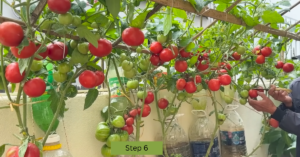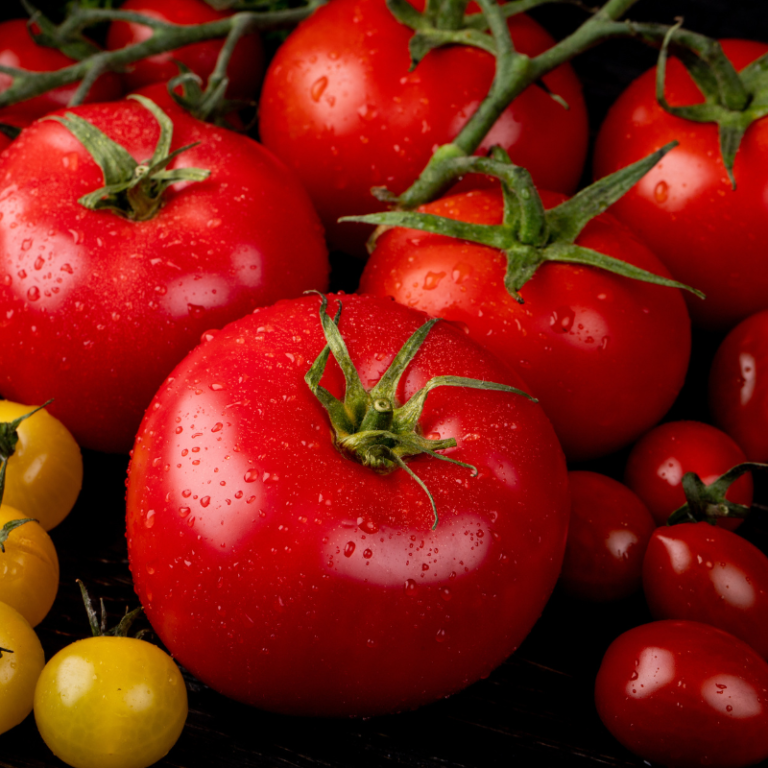Growing tomatoes at home can be a fun and rewarding experience, offering you the freshest, most flavorful fruits right from your garden. With the right approach, even beginners can successfully grow tomatoes in various settings, from backyard gardens to small containers. Let’s dive into everything you need to know to get started!

Choosing the Right Tomato Varieties
The first step to success is choosing the right tomato varieties for your space and needs. There are two main types:
- Determinate (Bush) varieties: These tomatoes grow to a specific size and produce all their fruit at once, making them perfect for smaller spaces or containers.
- Indeterminate (Vining) varieties: These keep growing and producing fruit throughout the season, but they require staking or caging for support.
When selecting your tomato types, consider whether you prefer heirloom varieties for their unique flavors and shapes, or hybrid varieties, which are bred for higher yield and disease resistance. For a comprehensive guide to planting tomatoes, check out how to plant and grow tomatoes.
Best Locations for Growing Tomatoes
Tomatoes need plenty of sunlight, so choose a location that gets at least 6-8 hours of direct sunlight each day. Whether you’re growing in a garden bed or a container, the key is having well-draining, fertile soil.
- In garden beds: Amend your soil with compost to improve fertility. Tomatoes prefer slightly acidic soil with a pH between 5.8 and 7.
- In containers: Use high-quality potting soil mixed with compost. Avoid heavy garden soil in containers as it may compact and retain too much water.
For a deeper dive into DIY home vegetable gardening tips, this DIY Home Gardening Guide offers helpful information for optimizing your garden space.
When and How to Plant Tomatoes
Tomatoes can be started from seeds indoors or grown from transplants. If you start from seeds, plant them indoors about 6-8 weeks before the last expected frost date in your area.
Here are a few essential tips for planting tomatoes:
- Planting depth: Remove the lower leaves and bury the plant deep, so part of the stem is below the soil. This encourages a stronger root system.
- Spacing: Plant smaller bush tomatoes about 24 inches apart, while vining varieties need 36-48 inches of space.
- Support: Be sure to stake or cage your indeterminate tomatoes early to support their growth and keep fruit off the ground.
Watering and Mulching Your Tomatoes
Proper watering is crucial for growing healthy tomatoes. Aim to keep the soil consistently moist, but not waterlogged, and avoid getting water on the leaves to prevent disease.
- Watering tips: Water at the base of the plant using a drip irrigation system or a watering can to avoid wetting the foliage.
- Mulching: Apply a 3-4 inch layer of mulch around your tomato plants to help retain moisture, reduce weeds, and prevent soil-borne diseases from splashing onto the leaves.
Fertilizing Your Tomato Plants
Tomatoes are heavy feeders, so they need nutrient-rich soil to produce a good yield. Here’s when to fertilize:
- First stage: Fertilize right after planting with a balanced liquid fertilizer, like 5-5-5.
- Second stage: Fertilize again just before the fruit begins to set to encourage healthy growth and better fruit production.
Common Tomato Pests and Problems
Growing tomatoes at home can attract a variety of pests, such as tomato hornworms, aphids, and whiteflies. To keep your plants healthy, inspect them regularly for signs of pests and damage.
Natural pest control methods include:
- Neem oil: An organic solution to fight common pests without harming beneficial insects.
- Insecticidal soap: Safe for organic gardening, it works effectively against aphids and whiteflies.
If you’re looking for more eco-friendly pest management tips, check out this guide to organic pest control.
Pruning and Maintenance
While pruning your tomato plants isn’t strictly necessary, removing suckers—the small shoots growing between the main stem and a branch—can help direct the plant’s energy toward fruit production rather than foliage. Be sure to keep the area around the plants clean and free of weeds to minimize disease risk.
Harvesting and Storing Tomatoes
Tomatoes are ready to harvest when they are fully colored and slightly firm to the touch. For the best flavor, allow them to ripen on the vine. If you need to harvest before they ripen due to an early frost, you can place green tomatoes in a paper bag indoors to ripen.
- Storage: Keep ripe tomatoes at room temperature. While refrigeration can extend their shelf life, it can also reduce their flavor and texture.
FAQs: Growing Tomatoes at Home
-
When should I start tomatoes indoors?
Start seeds indoors about 6-8 weeks before the last frost date in your area. -
How long does it take to grow tomatoes?
Depending on the variety, tomatoes take between 60-85 days to mature from planting to harvest. -
Can I grow tomatoes in pots?
Yes, you can! Choose determinate varieties for containers and ensure your pots have good drainage. -
How often should I water tomato plants?
Tomatoes need about 1-2 inches of water per week, depending on the weather. -
What causes tomato leaves to curl?
Leaf curl can be caused by environmental stress, such as heat or inconsistent watering, or by pests like aphids.
Conclusion
Growing tomatoes at home is both satisfying and straightforward with the right preparation. By selecting the appropriate varieties, providing proper care, and staying vigilant against pests, you’ll be rewarded with a bountiful harvest of fresh, delicious tomatoes. Follow these tips, and you’ll soon be enjoying your own home-grown produce!
